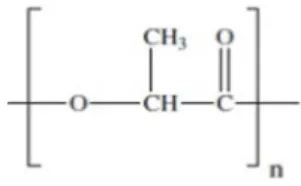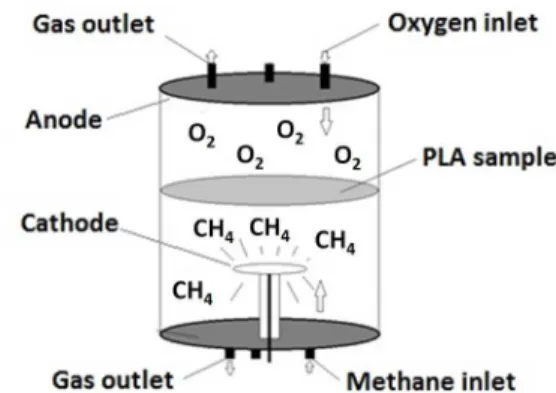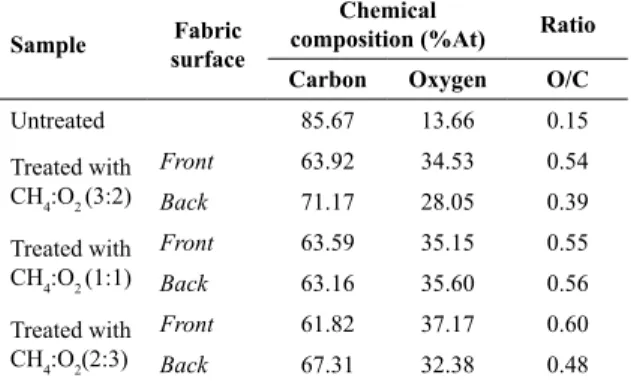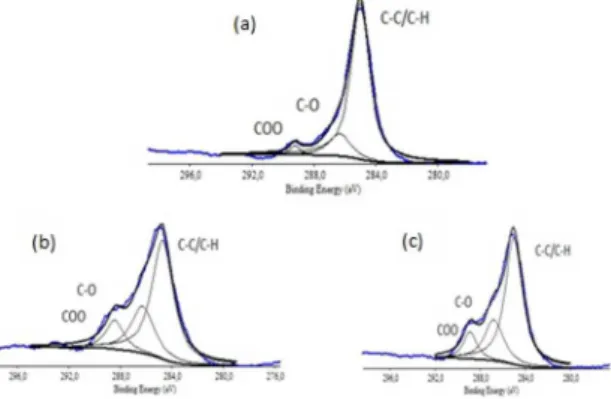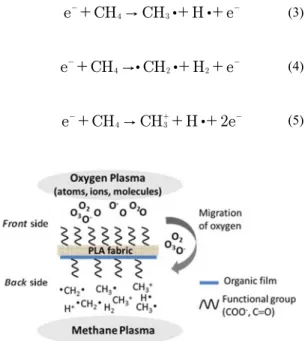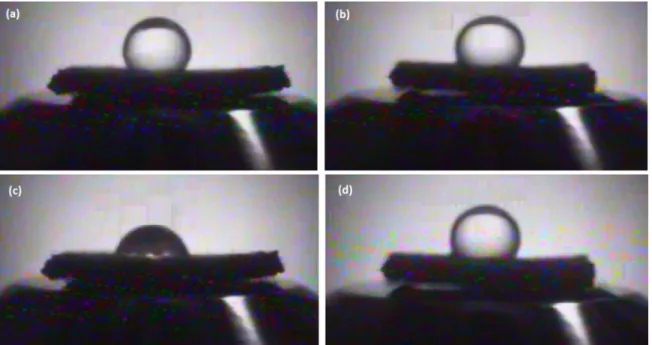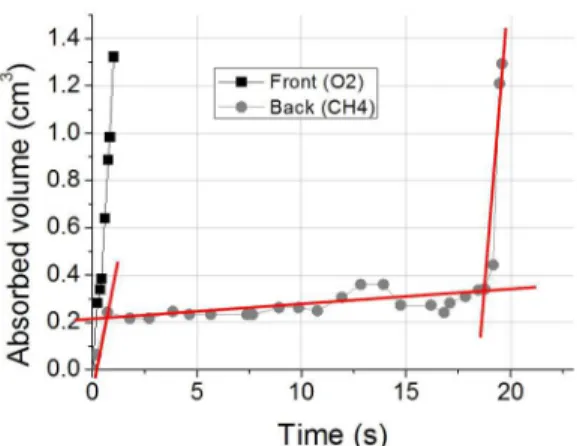Controlling Wettability of the Each Side of the PLA Fabric through Orientation of the
Working Gases (O
2and CH
4) During Cold Plasma Treatment
Ruthilene Catarina Lima da Silvaa*, Clodomiro Alves Júniorb,c, Jorge Reinaldo Oliveira Nevesd,
Rubens Araujoc, Vasco Manuel Pinto Teixeirad
Received: May 30, 2016; Revised: September 17, 2017; Accepted: October 25, 2017
This study aimed to obtain a bifunctional fabric from the point of view of hydrophilicity/ hydrophobicity for biomedical applications. To achieve this, both sides of a fabric of polylactic acid (PLA) were subjected to a plasma treatment. While in a side the oxygen was introduced to the other side, simultaneously, was added methane. The plasma treatment was performed at 100 W, 1.8 mbar, during 30 minutes. By Scanning Electron Microscopy (SEM) morphological analysis, it became evident that the fabric side facing the oxygen inlet showed micropittings, while the reverse side had smooth surfaces. Analysis by X-Ray photoelectron spectroscopy (XPS) revealed an increase in the amount of oxygen in the surface of the PLA on both sides of the fabric. The surface function was characterized by measurements of water absorption rate, where it was determined that one fabric side was more hydrophilic than the other side. The results indicated achievement of a bifunctional fabric through orientation of working gases during a plasma treatment.
Keywords: Plasma treatment, PLA, hydrophilicity, bifunctionality
*E-mail: ruthilima@yahoo.com.br
1. Introduction
Biological properties as biocompatibility and biodegradability of synthetic polyesters made from base monomers of lactic, glycolic and caprolactana acids opened space for their use in biomedical applications such as surgical sutures and staple
wire fixing bones, since they eliminate the need for further
surgery to remove this material1,2. Among the biodegradable polyesters can highlight the PLA (poly lactic acid or polylactide), Figure 1, as promising for such applications
due its profile of mechanical properties and its ability to
decompose into nontoxic byproducts (lactic acid, CO2 and H2O) when within the human body3. However, this material has intrinsic features such as slow degradation rate, high rigidity and crystallinity (around 40%), and hydrophobicity
that limits its application in the surgical field. For example,
a PLA implant is degraded with a reduction in weight of 63.2% within 168 days and it is estimated that complete degradation occurs in one and a half year or more2,3.
When PLA is used as suture threads, during the decomposition process will become more hydrophilic, increasing absorption of water, thus accelerating the degradation, despite this degradation time may take from days to years depending upon the formulation and the molecular weight2,4. Tissue engineering has also made use of this polymer as
three-dimensional porous structures, technically called "scaffold"
which aims to allow the entry, adhesion and proliferation of regenerative cells. The choice of PLA for this application is due to its good mechanical properties, low immunogenicity and adjustable rate of degradation. However, its hydrophobic
character provides inefficient cell interaction5,6.
Two alternatives have been used to attempt to optimize
the use of this polymer in the biomedical field. The first is
related to the polymerization process where lactic acid is copolymerized with another biodegradable polymer aiming
to introduce significant changes in the physical properties
of the PLA. The second alternative is associated with the
polymer surface modification by plasma processing, where
it is possible to introduce polar functional groups on their
surface and, thus, increase the hydrophilicity and cell affinity.
Furthermore, it is possible to modify the surface morphology of the polymer through this type of processing. According to Chang and Wang (2011)7 and Washbum et al. (2004)8
aCTMA, Instituto Federal de Educação, Ciência e Tecnologia do Rio Grande do Norte, Mossoró, RN, Brazil bLaboratório de Processamento de Materiais por - Labplasma, Universidade Federal Rural do
Semi-Árido, Mossoró, RN, Brazil
cPrograma de Pós-Graduação, Departamento de Engenharia Mecânica, Universidade Federal do Rio
Grande do Norte, Natal, RN, Brazil
dDepartamento de Física, Universidade do Minho, Braga, Portugal
the surface morphology is directly associated with cell
proliferation and inflammatory response of the material, and
therefore should be considered when working with surface
modification of a biomedical polymer.
Morent and Geyter (2012)9 highlight the introduction of functional groups containing oxygen and nitrogen on the surface of the PLA as a way of increasing their hydrophilicity. This can be achieved by performing a cold plasma treatment using gases such as O2, N2, NH3 and air. Another route to follow in order to increase the hydrophilicity of the polymer is performing the plasma treatment using argon or pure helium because these gases lead to the creation of free radicals that can be used for cross-linking of groups oxygen-containing when the surface is exposed to air or oxygen after treatment.
Kim and Masuoka4 performed plasma treatment by Radio Frequency (RF) on PLA substrate using CO2 as the working gas. They found that it is possible to change the rate of reaction for degradation in various chemical
environments and identified the presence of functional
groups with carboxylic and carbonyl bonds, which resulted in the increased hydrophilicity and biodegradability of this polymer. Armentano et al. (2009)6 studied the treatment of
PLA scaffolds with oxygen plasma by RF at 13.56 MHz,
varying the energy applied to 10 W and 20 W and the time in 2, 5 and 10 minutes, and evaluated the adsorption of a bovine protein. They showed changes in roughness and wettability that allowed better interaction between the PLA and the protein, demonstrated also that the energy of
20 W had a greater efficiency in reducing the contact angle with respect to 10 W, ie, increased more significantly the
wettability of the PLA.
In this paper is presented a study of the cold plasma treatment of a 100% PLA fabric, in order to acquire a
bifunctional material with different surface characteristics on
each side of the fabric. For this, it was performed a plasma treatment, where working gases, oxygen and methane entered, simultaneously, into the reactor by separate inputs and each
gas focused on a different side of the fabric. It was sought further to examine the influence of the ratio of gases on the
functional groups formed by plasma.
2. Experimental
A fabric 100% PLA with a weight of 210 g/m2, 21 courses/ cm and 13 wale/cm and a loop length of 0.27 cm, was used in this research. Before the plasma treatment of the fabric samples were washed in a bath of distilled water with 1% nonionic detergent at 40 °C for 30 minutes. Then, the samples were cut and packed in accordance with ASTM D1776.
PLA fabric samples were treated with cold plasma, where it was sought to produce a fabric with distinct characteristics on both sides. One side of the fabric being hydrophilic and the other side hydrophobic. For this, it was chosen to insert in the reactor, oxygen and methane gases orientated
to opposite sides of the fabric. The use of O2 on one side of the fabric aim of increasing the number of polar functional
groups and so the affinity with water. The choice of CH4 on the other side of the fabric is associated with the creation
of a hydrophobic surface to allow fluid to be expelled from this side of the fabric. Thus, the fluid penetrates into the
fabric through the hydrophilic side being ejected from the hydrophobic side, causing the fabric to act as a pump. In
addition, it was evaluated the influence of the proportion
of gases CH4:O2, where three settings were applied, 3:2, 1:1 and 2:3.
The plasma glow discharge was generated by a system consisting of a direct current (DC) source, a vacuum pump and a process gas distribution. This plasma was produced in a reactor made of a cylindrical borosilicate glass tube, 180 mm x 300 mm (diameter x height) closed by two stainless
steel flanges. The PLA sample was inserted into the reactor
and stood between two electrodes (anode and cathode)
to 12 cm away from the cathode. In the bottom flange is
coupled instruments as a mechanical pump, thermocouple, and pressure gauge.
During the experiments methane was introduced through
the bottom flange while oxygen was added to the reactor through the upper flange, as shown diagrammatically in
Figure 2. The fabric side facing the entrance of oxygen was titled "front", while the fabric side facing the entrance of methane was titled "back".
Figure 2. Schematic drawing of the inlet of gas into the plasma reactor system used in the treatment of the PLA samples
The plasma was produced at a power of 100 W and a pressure of approximately 1.8 mbar. It was used a duration of 30 minutes of treatment.
2.1 Surface characterization
The PLA surface of the fabrics was examined before and after plasma treatment by Scanning Electron Microscopy (SEM)
in order to identify physical changes in fiber morphology.
The surface composition of the samples was determined by X-rays photoelectron spectroscopy (XPS) using an
equipment ESCALAB Model 200A (VG Scientific, UK)
with PISCES software acquisition and data analysis. The
X-ray source was Al Kα (1486.6 eV), operating at 300 W.
The pressure within the XPS chamber was less than 10-6 Pa.
The effect of the electric charge was corrected by the
reference of the carbon peak (285 eV). The modeling of the spectra was performed using the program XPSPEAK41, wherein an adjustment of peaks with a Gaussian-Lorentzian shape and type Shirley background subtraction was performed.
2.2 Measurement of water absorption rate
To perform the measurement of the rate of water absorption by the fabric it was used the principle of that when surface tensions act, a sessile drop on a surface can take the form of a spherical cap, Figure 3. If the radius is a and h is the height of the cap, the volume of the spherical cap is given by equation (1). Therefore, an experiment was conducted using a pipette with adjustable volume to 20 µl drop, where the drop was placed on the sample and images were recorded. The size of the cap varies with time due to absorption of the liquid by the fabric, thus the variations in the h and a were measured over time and the values were applied to Equation 1 to obtain the volume of a cap in a given time, V (t). This enabled the calculation of the volume absorbed by fabric using the equation (2).
(1)
(2)
The results of the atomic oxygen percentage indicated a strong relationship with the proportion of gases used in the plasma treatment, where it was noted that the increase in the amount of O2 added in the reactor, compared to methane, resulted in an increase in the amount of oxygen present on the surface of the samples after the treatment.
The O/C ratio to different proportions of gases used
in the plasma treatments are shown in Figure 4. The O/C ratio it was increased by the plasma treatment, where can be observed a tendency to follow the proportion of CH4:O2 inserted in the reactor. It was observed, for instance, that after treatment in a proportion 2:3 the O/C changed from 0.15 to 0.60 on the side facing the O2 inlet (front) and to 0.48 on the side facing CH4 input (back). A similar result was
also identified in treatment with other proportions, as can
be seen in Table 1. As evidenced in Figure 4, the increase in O/C is more intense for the fabric side facing the entrance of oxygen (front) except to the ratio 1:1, where both sides of the fabric showed similar values. During treatment, the methane molecules were activated and formed polar functional groups when in contact with oxygen. In the ratio 1:1, more oxygen
was available in the reactor to find active molecules formed
by methane in relation to the proportion 3:2, and therefore the value of O/C at the back side was higher. In the ratio 2:3, despite having more oxygen present, less methane was added, and therefore lower number of active molecules were formed on the back surface, so that there was a reduction in the value of O/C compared to the ratio 1:1.
For the fabric to act as a pump, the hydrophilic side must
be as hydrophilic as possible to allow the fluid penetrate the
tissue, overcome the hydrophobic barrier and be expelled by the hydrophobic side. Therefore, it was decided to further analyze the ratio 2:3 since in this condition it was found higher O/C for the oxygen input side and thus more functional groups have been created, making this side of the fabric more hydrophilic.
The de-convolution of the C1s peaks was performed for the untreated samples and treated with 2:3 ratio, the result is shown in Figure 5. Is noted the appearance of three components with a binding energy of 284.7, 286.4 and 288.7
V
h
a
h
6
1
3
2 2r
=
Q
+
V
V
absorbed=
V
0-
V t
Q V
Figure 3. Schematic drawing of spherical cap of height (h) and radius (a), formed when a sessile drop reaches a fabric sample.
3. Results
Table 1 shows the values of atomic percentage of chemical
elements identified by XPS and their reasons oxygen/carbon (O/C). It is observed that the plasma treatment is effective concerning surface modification of PLA since was obtained
variations in the atomic percentages of carbon and oxygen as compared to the untreated sample.
Table 1. Chemical composition and O/C ratio by XPS to each surface of untreated and treated samples.
Sample Fabric surface
Chemical
composition (%At) Ratio Carbon Oxygen O/C
Untreated 85.67 13.66 0.15
Treated with CH4:O2 (3:2)
Front 63.92 34.53 0.54
Back 71.17 28.05 0.39
Treated with CH4:O2 (1:1)
Front 63.59 35.15 0.55
Back 63.16 35.60 0.56
Treated with CH4:O2(2:3)
Front 61.82 37.17 0.60
that the two sides of the fabric, front and back, showed an increase in the concentration of polar groups CO and O=CO and reduction in the concentrations of nonpolar groups CC/CH. The inlet side of gas is also a parameter to control during
the treatment procedures since were identified different
results to the inlet side of methane relative to the inlet side of oxygen. The front surfaces of the fabric gained more oxygen than back surfaces, this result points to a greater creation of hydrophilic functional groups on the inlet side of the oxygen. However, it is possible to note that the atomic
percentage of oxygen also had a significant increase in the
inlet side of methane. Two factors may explain this result:
(1) during treatment oxygen diffused into the reactor and
therefore was present throughout the internal volume, so these atoms also reached the back surface, forming polar functional groups; (2) remained active species on the surface of the fabric and react with the oxygen present in the air after the plasma treatment. Lima da Silva et al. (2012)12 studied the cold plasma treatment of polyester fabric with various proportions of gases. They observed by means of XPS that using Ar and N2 gases there was an increase in the concentration of O2 on the surface of the fabric. The authors suggested that active species generated during the action of the plasma remained on the surface of the material and reacted with oxygen in the air after treatment, forming polar groups. Garcia et al. (2008)13 when studying plasma treatment of PP in an atmosphere of CH4:O2 (8:2), also
identified an increase in the O/C ratio, of 0.04 for 0.13 after
60 s treatment. According to these authors, the use of plasma containing an organic monomer such as methane is known as plasma polymerization, resulting in the deposition of organic material on the substrate. In their study, the organic material was rich in oxygen, since O2 was also introduced into the plasma, and this has made the carbon concentration
at the surface decreased, as identified by XPS. In the present work, can be identified the deposition of organic material on the fiber of the PLA, to the surface facing to the inlet of
methane by images of SEM presented in Figure 6. Images by scanning electron microscopy (SEM) of the PLA before and after treatment with plasma ratio of 40% CH4 + 60% O2 are shown in Figure 6. The surface of the front side of the fabric before treatment showed a slightly wrinkled texture (Figure 6a), with ripples that gave way to small pits after plasma treatment with a direct incidence of oxygen (Figure 6c). A similar result was observed by Kim and Masuoka (2009)4 when they performed the plasma treatment of PLA, using CO2 as the working gas, they attributed this phenomenon to several factors such as attack,
the bombardment of ions, radicals or UV irradiation of the
plasma. According to these authors, the presence of pits can
increase the surface reactivity of the fibers, resulting in a
higher rate of degradation of this polymer. Abdrabbo and Wardman (2010)14 obtained similar results for PLA after it is subjected to plasma at low temperature using oxygen as the ionizing gas.
Figure 4. O/C ratio at the surface of the fabric PLA untreated and two sides of the PLA plasma-treated (front and back) at different
ratios of O2 and CH4
eV in the untreated sample, Figure 5 (a). The peak 284.7 eV corresponds to the CC / CH bond, the peak 286.4 eV is the
CO bond and finally the peak 288.7 eV appears due to the
presence of group O = CO in the chain. When examining the de-convolution of the treated samples (Figures 5b and 5c) is observed changes in peaks intensities found in the untreated sample. Where peaks related to groups O=C-O and C-O increased intensity, while the C-C and C-H groups decreased.
Figure 5. Deconvolution of the C1s peak of carbon for (a) untreated sample (b) front side of treated sample 40% CH4 + 60% O2 (c) back side of sample treated with 40% CH4 + 60% O2
No new peaks were identified in the treated samples,
indicating that new functional groups were not formed. A similar result was obtained by Prissanaroon-Ouajai et al. (2010)11 that treated PLA films by the same method (plasma glow discharge) and used argon as the working gas. The treatment was made with a power of 18 W and duration of 5 minutes, and then the samples were exposed to atmospheric air for 10 minutes. New functional groups
were not identified by XPS, but it was noted a rise in the
intensity of the oxygen-containing groups.
Table 2 shows the concentrations of functional groups
Table 2. Concentration of functional groups identified by the convolution-C1s to sample untreated and treated to plasma with CH4:O2 (2:3)
Sample Functional groups
C-C/C-H C-O O=C-O
Untreated 83.04 14.25 2.71
CH4:O2 (2:3)
Front 61.41 26.03 12.56
back 65.49 23.50 11.01
Figure 6. Image by scanning electron microscopy of the fabric: (a)
front side of untreated sample, (b) back side of untreated sample, (c) front side after treatment with 100W, 30min and 40% CH4 + 60% O2, (d) back side after treatment with 100W, 30min and 40% CH4 + 60% O2
The surface of the back side of the fabric prior to treatment also had slightly wrinkled texture (Figure 6b) and after plasma treatment (inlet side of methane) is noticed
that there was the formation of a smooth layer on the fibers
of PLA and that this layer had a tendency to involve the
whole fiber (Figure 6d). The reactions that occur with the
methane plasma can result in the formation and deposition of an organic material on the surface of the polymer due to the generation of active species such as •CH2•, •CH3 and CH3+ as observed in the equations (3), (4) and (5). A similar result was found by Awaja et al. (2010)15 after treating the polymer polyether ether ketone (PEEK) by RF plasma using methane as the working gas, with 125 W for 0.5 min. They realized that before treatment the polymer was wrinkled, with cracks that tended to disappear after treatment with CH4, indicating an effect of smoothing by exposure to plasma. Garcia et al. (2008)13 reported identify the deposition of an organic material rich in oxygen on the surface of polypropylene (PP), when treated with RF plasma in methane-oxygen mixture (80:20) at a power of 150 W. The authors studied the surface energy of the treated PP and obtained lower values of dispersive component, indicating
a low attack effect of the gaseous mixture.
As is evident from the pictures, the difference in the surface morphology of the fibers obtained during the plasma
treatment, the front side (associated with the oxygen inlet) presented pits, while the back side (associated with the entry methane) resulted in a smooth surface.
Figure 7 presents a schematic diagram elaborated from the analysis of the results of XPS and SEM. This diagram represents the process occurring with the PLA surface during the plasma treatment. On the front side of the fabric there was functionalization of the surface by the oxygen plasma (atoms, ions and molecules of oxygen) with the formation of groups containing oxygen (CO and COO). In the meantime, on the back side occurred deposition of organic material as coating due to methane plasma, where the molecules and ions formed by plasma tend to return to its equilibrium state through the bonds between •CH2• and •CH3. Migration of oxygen from the front side to the back side explains the increase of functional groups containing oxygen on the back side as observed by XPS analysis showed in Table 2.
(3)
(4)
(5)
e
+
CH
4"
CH
3:
+
H
:
+
e
-
-e
+
CH
4"
:
CH
2:
+
H
2+
e
-
-e
+
CH
4"
CH
3+
H
:
+
2
e
- +
-Figure 7. Schematic diagram of the process occurring simultaneously with the PLA fabric, during the plasma treatment
3.1 Rate of Water Absorption
Figure 8. Images of water drop on the PLA fabric treated with 100 W, 30 min and 40% CH4 +60% O2 (a) Front (oxygen), outset of the application of the drop; (b) Back side (methane), outset of the application of the drop; (c) Front (oxygen), 0.5 seconds after application of the drop; (d) Back side (methane), 15 seconds after application of the drop
front (Figure 8c) side and 15 seconds after application of the drop on the back side (Figure 8d). It can be seen that
the height of the drop decreased significantly before than 1
second for the front side, which, however, had a little height
difference on the back side after the lapse of 15 seconds. Variations in the height and radius formed by the cap of the droplet are presented in Figure 9. It can be seen that at just over 1 second the drop disappeared from the front side of the fabric while take more than 20 seconds to be absorbed by the back side of the fabric. The radius varied virtually at the
same rate that the height to back side (CH4), as highlighted by the lines in Figure 9(a), indicating that the liquid spread on the fabric more than penetrate. However, the variation rate of the radius to the front side (O2) in relation to height was less (Figure 9b), suggesting that the liquid penetrated more than spread.
The absorbed volume values were calculated and are shown as a function of time in Figure 10. The side of the fabric facing the entrance of oxygen presented rapid absorption of the liquid, where it can be noticed two stages
in the graphic, the first stage until 0.4 s refers to the dynamic wetting process that result of the pressure of the impact of the drop to achieve the fabric, while the second, from 0.4 s with respect to the capillary penetration process. The side of the fabric facing the entrance of methane showed three
stages of water absorption, where the first, to 1 s, is associated
with the dynamic wetting effect, the second one between 1 and 16 s, the quasi-static wettability and the third refers to the capillary wicking. The behavior of a drop on a fabric was presented by Calvimontes et al. (2010)16, where they explained on three distinct stages of wetting of a textile surface. According to Sharabaty et al. (2008)17 the wettability is a prerequisite to occur capillary wicking, moreover, wicking takes place when the liquid travels along on the surface but
is not absorbed into the fibers. Therefore the prolonged time
of quasi-static wettability for the back side is explained by
organic film deposited on this side, observed by SEM, that
acted as a barrier to absorption of the liquid and the third stage, wicking, occurred through of the wetting originated
Figure 10. Amount of water absorbed on the two sides of the fabric treated with 100 W, 30 min and ratio of 40% CH4 + 60% O2
by the presence of functional groups, identified by XPS,
with posterior spreading of the liquid.
It may be noted that only the presence of CO and COO functional groups on the fabric does not ensure that it has fast water absorption, since was found deposition of a product of polymerization on the back side of the fabric, as observed by SEM, which despite containing oxygen resulted in a slow rate of water absorption by fabric.
4. Conclusions
The cold plasma treatment was performed on samples of 100% PLA fabric using methane and oxygen as working gases. The results showed that
1. The treatment was successful in providing
bifunctionality superficial, through the distinct
characteristics obtained from both sides of the treated fabric, as intended.
2. The side of the fabric facing the entrance of oxygen showed the presence of small pits on the surface
of the fibers of the fabric, identified by SEM, and higher intensity of polar functional groups verified
by XPS. Whereas the side of the fabric facing the entrance of methane had a smooth surface, suggesting an organic material deposition on the
fibers of the fabric. It was also found an increase
in the presence of polar functional groups on that side of the fabric.
3. It was found that the ratio of gas added to the
plasma reactor had an influence on the number of
functional groups present on the fabric, where the higher the amount of added oxygen ratio greater the O/C found on the surface of the PLA. 4. The difference in morphology and surface chemistry
on both sides of the fabric, obtained by the plasma treatment, points to the possibility of obtaining a bifunctional fabric, since one side of the fabric had high wettability and fast water absorption, while the other side proved to have wettability, but little water absorption characteristic of the wicking.
5. Acknowledgement
The authors are acknowledging to financial support
supplied by CAPES - Brasília/Brazil through of the CAPES/ IGC program - CGCI n° 055/2010.
6. References
1. Madhavan Nampoothiri K, Nair RJ, John RP. An overview of the recent developments in polylactide (PLA) research.
Bioresource Technology. 2010;101(22):8493-8501.
2. Gupta B, Revagade N, Hiborn J. Poly(lactic acid) fiber: An
overview. Progress in Polymer Science. 2007;32(4):455-482.
3. Drumond WS, Wang SH, Mothe CG. Síntese e caracterização do copolímero poli (ácido lático-b-glicol etilênico). Polímeros. 2004;14(2):74-79.
4. Kim MC, Masuoka T. Degradation properties of PLA and
PHBV films treated with CO2-plasma. Reactive and Functional Polymers. 2009;69(5):287-292.
5. Morent R, De Geyter N, Desmet T, Dubruel P, Leys C. Plasma
Surface Modification of Biodegradable Polymers: A Review.
Plasma Processes and Polymers. 2011;8(3):171-190.
6. Armentano I, Ciapetti G, Pennacchi M, Dottori M, Devescovi
V, Granchi D, et al. Role of PLLA plasma surface modification
in the interaction with human marrow stromal cells. Journal of Applied Polymer Science. 2009;114(6):3602-3611.
7. Chang HI, Wang Y. Cell Responses to Surface and Architecture
8. Washburn NR, Yamada KM, Simon CG Jr, Kennedy SB, Amis EJ. High-throughput investigation of osteoblast response to
polymer crystallinity: influence of nanometer-scale roughness
on proliferation. Biomaterials. 2004;25(7-8):1215-1224.
9. De Geyter N, Morent R. Non-Thermal Plasma Surface
Modification of Biodegradable Polymers. In: Ghista DN, ed.
Biomedical Science, Engineering and Technology. Rijeka: InTech; 2012.
10. Chieng BW, Ibrahim NA, Yunnus WMZW, Hussein MZ. Poly(lactic
acid)/Poly(ethylene glycol) Polymer Nanocomposites: Effects
of Graphene Nanoplatelets. Polymers. 2014;6(1):93-104. DOI: 10.3390/polym6010093
11. Prissanaroon-Ouajai W, Riegensilchai A, Anuwarreephong N, Ouajai S. Static Dissipative Biopolymer Composites Prepared by In Situ Polymerization of Polypyrrole on Poly(lactic acid) Surfaces. Journal of Metals, Materials and Minerals. 2010;20(3):81-85.
12. da Silva RCL, Alves C Jr, Nascimento JH, Neves JRO, Teixeira
V. Surface Modification of Polyester Fabric by Non-Thermal
Plasma Treatment. Journal of Physics: Conference Series. 2012;406:012017. DOI: 10.1088/1742-6596/406/1/012017
13. Garcia D, Fenollar O, Lopez R, Sanchis R, Balart R. Durability
of the wettability properties of a polypropylene film with a
low-pressure ch4-o2 plasma treatment. Journal of Applied Polymer Science. 2008;110(2):1201-1207.
14. Wardman RH, Abdrabbo A. Effect of plasma treatment on the
spreading of micro drops through polylactic acid (PLA) and polyester (PET) fabrics. AUTEX Research Journal. 2010;10(1):1-7.
15. Awaja F, Zhang S, James N, McKenzie DR. Enhanced Autohesive Bonding of Polyetheretherketone (PEEK) for Biomedical
Applications Using a Methane/Oxygen Plasma Treatment.
Plasma Processes and Polymers. 2010;7(12):1010-1021.
16. Calvimontes A, Badrul Hasan MM, Dutschk V. Effects of Topographic Structure on Wettability of Differently Woven
Fabrics. In: Dubrovski PD, ed. Woven Fabric Engineering. Rijeka: InTech; 2010.
